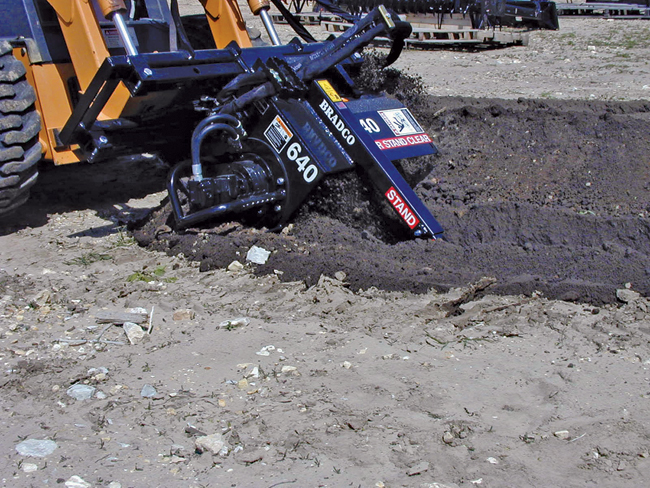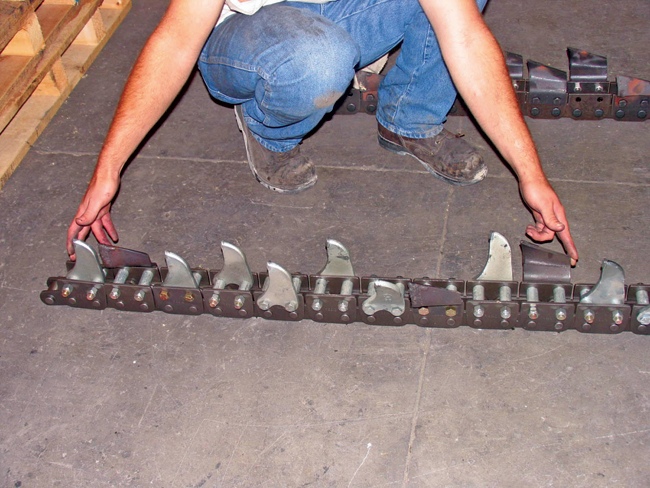Don’t Cut and Run
Maintenance — it’s an obvious requirement that keeps every piece of equipment running at maximum performance. Machines require routine upkeep to continue rolling large, but so do their attachments and implements. For instance, a skid steer will get a mechanic’s full attention and TLC, while the skid steer trenching attachment might get thrown into that I’ll-get-to-it-later pile. But, a lack of regular maintenance and inspection for a tough working implement like a trencher will result in a significant lack of performance.
“On average, it takes less than 30 minutes to learn all the proper maintenance and upkeep of a skid steer trenching attachment,” says Dave Aldrich, dealer development and service manager for Bradco Attachments. “While it doesn’t take long to perform the actual maintenance checks, the importance is very high. Improper maintenance can cause excessive wear on ground contact parts, overheating of the machine and costly bearing and headshaft damage to the trencher attachment that can be easily avoided.”
Before You Start, Check the Basics
Before your trencher touches the dirt, match the tooth type and pattern with your soil type. Talk with your dealer or manufacturer representative about the soil type you will be digging into. Then, choose the proper teeth for your application:
- Cup: The most common teeth chosen for skid steer trencher attachments. Ideal for good digging applications like black dirt, loam, moist clay, sand and sandy clay.
- Shark: Ideal for rocky, abrasive or compact conditions like caliche.
- Frost: Ideal for the most extreme trenching applications like coral, frozen ground and fracturable rock.
One of the most commonly overlooked maintenance requirements is the appropriate adjustment of the digging chain tension. If the tension is too loose or too tight, it will cause excessive wear on the sprockets, idler bearings and chain. For many skid steer trenching attachments, there is a full adjustment on the boom so you can set the proper tension. When tensioned, put the trencher attachment in the horizontal position and check the sag of the chain. The typical maximum sag is about 1 1/2 in. Always check your manual first because boom styles vary.
Your Daily Inspection Checklist
Unlike a dedicated trenching machine, a skid steer trenching attachment has few moving parts. It is hydraulically driven so there are no pivot points, belts, pulleys or clutches and there are fewer bearings and pins — but the trencher must still be inspected each day before use. Be sure to reference your manual for specific maintenance checks, but here are some of the basics that apply to most models.
- Eye Test: Walk around your machine and look for noticeable loose bolts, cap screws, fittings and bearings and confirm all safety shields are in place.
- Hoses: Inspect all hydraulic hoses to make sure they haven’t been damaged or pinched by the skid steer frame. Since skid steer trenching attachments often dig at 60- to 90-degree angles, hose pinching is possible. Pinching may cause hose rupture, collapse or restriction, often resulting in leakage and/or overheating of the hydraulic system.
- Chain Tension: Check the sag distance while in the horizontal position.
- Leakage: Examine the idler wheel and headshaft area for excessive grease leakage to diagnose damaged seals.
- Greasing: The headshaft should be greased after every eight hours of use with high-quality SAE multi-purpose grease. (Note: Some models have a sealed headshaft and don’t require greasing.)
- Teeth: Inspect the digging chain to make sure all teeth are in place, in good condition and the hardware around it is secure and tight on each link.
“Because tooth wear depends mostly on the soil type, a daily tooth wear check is critical to ensure maximum trencher performance,” says Aldrich. “A set of teeth can last as little as 10 hours or exceed 100 hours, depending on your soil. Once the teeth are at about 50 percent performance, the trencher will lose more in performance than it would cost for a new set of teeth. Plus, it will cut better, putting much less stress on the trencher components and skid steer.”
Routine Maintenance
In addition to daily inspection, a few routine checks are necessary to ensure peak trencher performance. The amount of hours put on your machine will define the required time frame of these checks. To be safe, perform the following a minimum of every three to six months.
- Cleanliness: To avoid overlooking worn or damaged components, clean the trencher with a power washer to eliminate all dirt, oil and grease. Keep all safety decals clean and legible.
- Boom Wear: Examine the underside and top part of the trencher boom. Replace the wear strips if you see grooves cut into the boom caused by the side plates of the chain.
- Digging Chain Wear: The tighter the chain tension, the more wear you will see on the rollers that are in contact with the drive sprockets. Replace the digging chain if there is a scooped or beveled groove in the center of the roller wear strips.
- Digging Sprocket System: When replacing the digging chain, or after every couple hundred hours of use, be sure to replace the drive sprocket as well, even if it’s not completely worn. A new digging chain will wear quicker if paired with a worn drive sprocket.
A Trencher Is Only as Good as Its Skid Steer
The trencher’s performance is directly related to the power available from the skid steer’s auxiliary hydraulic system. A trencher attachment is demanding on the skid steer’s hydraulic system, so routine skid steer maintenance is crucial. For example, regularly check the hydraulic oil levels and replace with the manufacturer-recommended oil when dirty or low.
Storing for More Than 60 Days
When the trenching season is over or for long-term storage, a few maintenance precautions should be taken to ensure your skid steer trenching attachment runs perfectly next time. Here are some common tips when storing for more than 60 days.
- Clean It Again: A lot of soils are corrosive if they build up and sit on your attachment for a long period of time. Plus, soils can freeze in the chain assembly if left in cold weather.
- Protect the Chain: Clean the digging chain and its rollers and spray a light oil or seal protectant on them to eliminate rusting. Do another walk around eye test and replace any broken components before storing. It is often difficult to remember these small fixes the next time you use it.
Safety is just as important as maintenance. Before performing any maintenance on the skid steer trenching attachment, lower the trenching boom and shut off the engine. Then, make sure all operating and residual pressures are relieved from the hydraulic lines. As always, read and follow your manual carefully.
Doug Amerman is the director of marketing and business development for Paladin Construction Group, which includes Bradco Attachments, based in Dexter, Mich.



Comments are closed here.